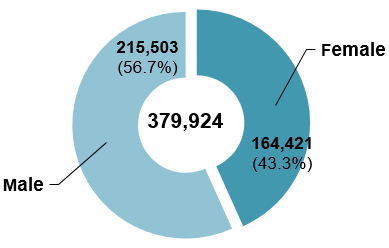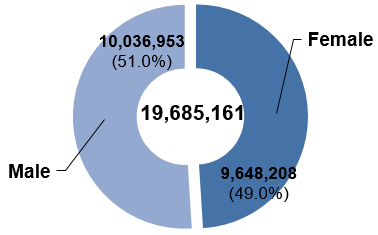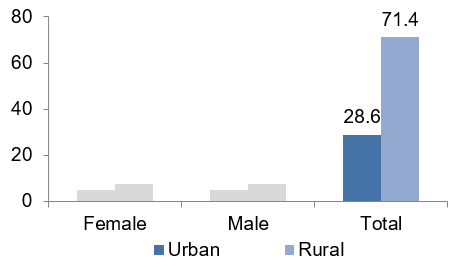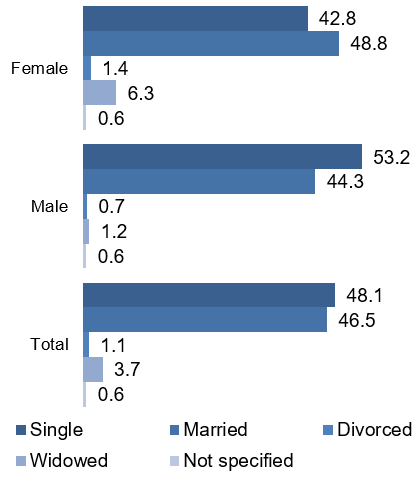Table of contents:
Yemen 2004
| HDI: | 0.428 | |||
|---|---|---|---|---|
| Life expectancy at birth: | 62.7 | |||
| GNI: | 2,020 | |||
Source: UNDP.
Figure 1: Persons with disabilities

| Female | Male | Total |
|---|---|---|
| 43.3% | 56.7% | 100.0% |
| 164,421 | 215,503 | 379,924 |
Figure 2: Total population

| Female | Male | Total |
|---|---|---|
| 49.0% | 51.0% | 100.0% |
| 9,648,208 | 10,036,953 | 19,685,161 |
Figure 3: Age distribution of persons with disabilities (in percentage)

| Female | Male | Total | |
|---|---|---|---|
| Total | 1.7 | 2.1 | 1.9 |
Type of disability / difficulty (in percentage)
| Female | Male | Total | |||||||
|---|---|---|---|---|---|---|---|---|---|
| Visual difficulty | 21.2 | 17.4 | 19.0 | ||||||
| Hearing difficulty | 11.6 | 10.0 | 10.7 | ||||||
| Speech difficulty | 4.3 | 5.0 | 4.7 | ||||||
| Speech and hearing difficulty | 4.2 | 3.9 | 4.0 | ||||||
| Difficulty in walking | 21.0 | 21.3 | 21.1 | ||||||
| Difficulty in movement | 7.0 | 6.6 | 6.8 | ||||||
| Difficulty in grasping objects | 3.8 | 5.2 | 4.6 | ||||||
| Mental difficulties | 10.7 | 17.3 | 14.5 | ||||||
| Two or more difficulties | 15.8 | 12.9 | 14.1 | ||||||
| Not specified | 0.5 | 0.5 | 0.5 | ||||||
Cause of disability / difficulty (in percentage)
| Female | Male | Total | |||||||
|---|---|---|---|---|---|---|---|---|---|
| Congenital (since birth) | 25.3 | 27.1 | 26.3 | ||||||
| Work-related accident | 1.7 | 4.5 | 3.3 | ||||||
| Accident | 1.7 | 4.6 | 3.4 | ||||||
| Road traffic accident | 8.9 | 12.9 | 11.1 | ||||||
| Disease / illness | 21.9 | 22.5 | 22.2 | ||||||
| Weapon-related accident | 0.4 | 2.6 | 1.7 | ||||||
| Land mines | 0.2 | 0.7 | 0.5 | ||||||
| Old age | 36.5 | 21.6 | 28.0 | ||||||
| Not specified | 3.5 | 3.5 | 3.5 | ||||||
Figure 4: Persons with disabilities by geographical location (in percentage)

| Female | Male | Total | |
|---|---|---|---|
| Urban | 22.1 | 25.2 | 23.9 |
| Rural | 77.9 | 74.8 | 76.1 |
Figure 5: Total Population by geographical location (in percentage)

| Total | |
|---|---|
| Urban | 28.6 |
| Rural | 71.4 |
Figure 6: Total population (10 years and above) by marital status (in percentage)

| Female | Male | Total | |
|---|---|---|---|
| Single | 42.8 | 53.2 | 48.1 |
| Married | 48.8 | 44.3 | 46.5 |
| Divorced | 1.4 | 0.7 | 1.1 |
| Widowed | 6.3 | 1.2 | 3.7 |
| Not specified | 0.6 | 0.6 | 0.6 |
Total population (10 years and above) by educational attainment (in percentage)
| Female | Male | Total | |||||||
|---|---|---|---|---|---|---|---|---|---|
| Illiterate | 61.6 | 29.6 | 45.3 | ||||||
| Read and write | 25.4 | 37.3 | 31.5 | ||||||
| Primary | 1.8 | 4.4 | 3.1 | ||||||
| Preparatory / basic / unified | 4.9 | 12.0 | 8.5 | ||||||
| Pre-secondary diploma | 0.1 | 0.6 | 0.4 | ||||||
| Secondary or equivalent | 3.9 | 10.4 | 7.2 | ||||||
| Post-secondary diploma | 0.4 | 1.6 | 1.0 | ||||||
| Bachelor | 1.0 | 3.5 | 2.3 | ||||||
| Post-graduate diploma | 0.0 | 0.0 | 0.0 | ||||||
| Master | 0.0 | 0.2 | 0.1 | ||||||
| Doctorate | 0.0 | 0.1 | 0.0 | ||||||
| Not specified | 0.9 | 0.6 | 0.7 | ||||||
Figure 7: Total population (15 years and above) by economic activity (in percentage)

| Female | Male | Total | |
|---|---|---|---|
| Employed | 5.6 | 58.7 | 32.1 |
| Unemployed | 3.7 | 8.8 | 6.2 |
| Not economically active | 87.9 | 31.2 | 59.6 |
| Not specified | 2.8 | 1.3 | 2.0 |
Source: Central Statistical Organization (2004).
| Convention | Signed | 30.3.2007 |
|---|---|---|
| Ratified / Acceded | 26.3.2009 | |
| Optional Protocol | Signed | 11.4.2007 |
| Ratified / Acceded | 26.3.2009 |
Source: UN (2014).
| National coordination mechanism: | Name: | The Disabled Care and Rehabilitation Fund (DCRF) |
|---|---|---|
| Year established: | 2002 | |
| Chair: | Executive Director of the Fund | |
| Persons with disabilities represented? | Yes | |
| Additional mechanisms: | System of focal points for disability related matters in line ministries or other governmental institutions | |
NATIONAL DEFINITION OF DISABILITY / PERSONS WITH DISABILITIES
A partially, but permanently, disabled person is every individual, male or female, with a permanent disability in one or some body parts, who can rarely work due to their condition. A person with temporary total or partial disability is every individual, male or female, with a disability in one or some body parts that lasts for a temporary period of their life and as a result cannot work outside of the limits of what their disability allows. A person with a permanent total disability is every individual, male or female, with a total disability that causes permanent inability to work. (Law no. 29 on Social Welfare, 2008).
| Articles on disability included in the constitution? | Yes |
|---|---|
| General / overarching national disability law | Law No. 2 on establishing the Disabled Care and Rehabilitation Fund (2002) |
| National disability strategy / plan | CBD |
Source: ESCWA, based on data collected from government focal points through the ESCWA Questionnaire on the Implementation of the Convention on the Rights of Persons with Disabilities and the Arab Decade for Persons with Disabilities (2013).
Footnotes:
1 Data for these three indicators is from 2005.